
The scaption exercise is an essential movement for enhancing shoulder health, offering significant scaption exercise benefits, especially for individuals recovering from shoulder injuries like impingement.
This exercise targets the shoulder muscles [1] by engaging the rotator cuff and stabilizing the shoulder blades. Starting from a position with feet shoulder-width apart, you can use dumbbells to perform controlled lifts while keeping your palms facing inward.
Certified personal trainer Carrie Andrade [3] emphasizes the importance or benefits of scaption exercise for shoulder joint health, noting that it not only strengthens the shoulders but also reduces the chances of injury. She recommends focusing on proper form and gradually increasing weight to avoid overstraining.
Incorporating dumbbell scaption into your exercise program promotes injury prevention, strengthens the shoulders, and improves overall fitness. By focusing on this movement, you can protect your body from future injuries while enhancing your training effectiveness.
Effective Exercises for the Scaption
These exercises help improve shoulder mobility and strengthen the surrounding muscles.
1. Dumbbell Scaption
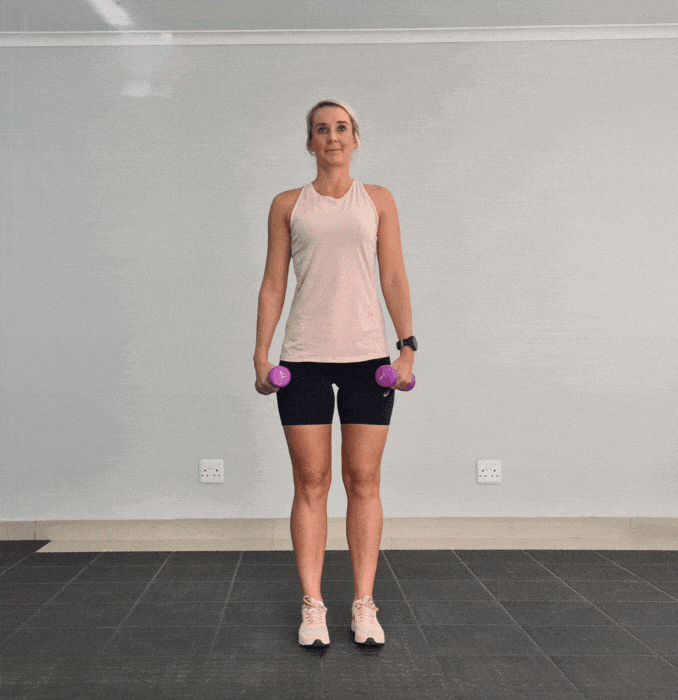
- Begin in an upright standing position with your feet shoulder-width apart, maintaining good alignment with your head, shoulders, hips, and legs.
- Hold a dumbbell in each hand. Engage your core.
- Lift your arms out to the side at shoulder level.
- Hold the position for a few seconds, and lower your arms to return to the starting position.
- Repeat the movement as needed.
2. Scaption with Resistance Bands
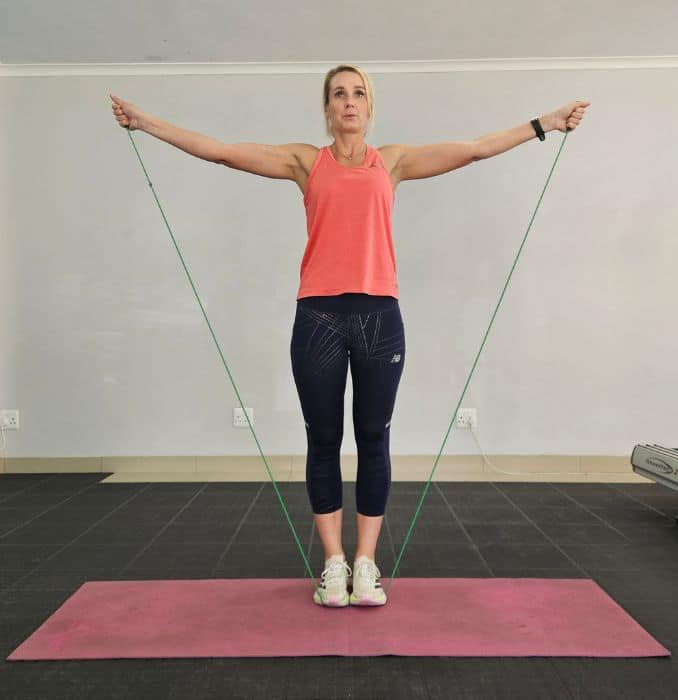
- Begin in an upright standing position with your feet shoulder-width apart, maintaining good alignment with your head, shoulders, hips, and legs.
- Step on the center of a resistance band with both feet.
- Hold the ends of the resistance band on each hand. Engage your core and lift both arms up in a “V” position, creating resistance to the band.
- Hold the position for a couple of seconds, lower your arms down to return to the starting position, and repeat the movement as needed.
3. Scaption Wall Slide
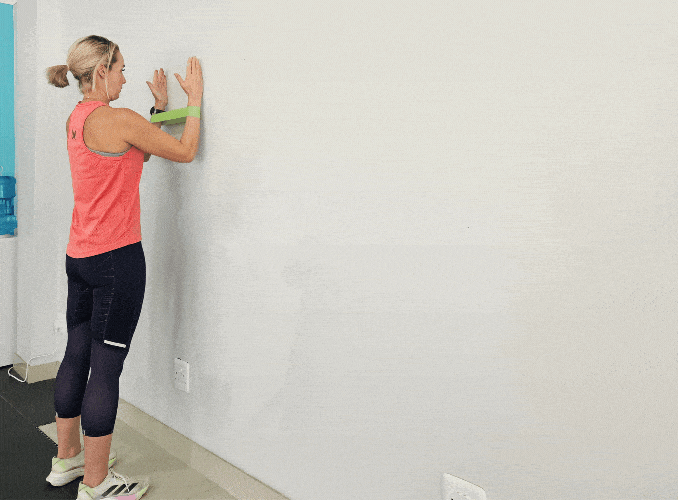
- Begin in an upright standing position in front of a wall with feet hip-width apart, maintaining good alignment with your head, shoulders, hips, and legs.
- Wrap a band around your arms just above your wrist.
- Place a foam roller on the wall and press your arms on it.
- Engage your core and slowly slide your arms up and down in a scaption motion while maintaining contact.
- Repeat the movement for 10 repetitions.
Additional Shoulder Mobility Exercises
1. Pendulum Swings
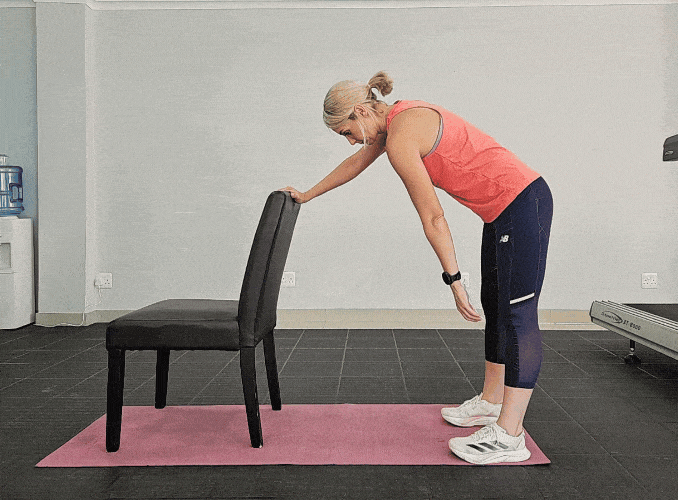
- Begin in an upright standing position at the back of a chair with your feet hip-width apart, maintaining good alignment with your head, shoulders, hips, and legs.
- Place one hand at the back of the chair for support.
- Engage your core and hinge through your hips to lean your upper body forward and let your opposite arm hang down, then gently swing it back and forth.
- Relax and repeat the movement on the opposite side
2. Wall Angels
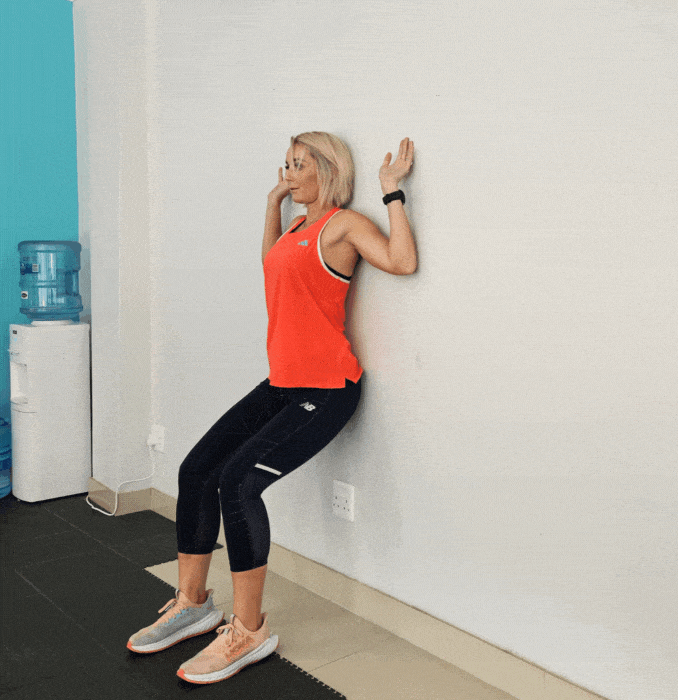
- Begin in an upright standing position with your back against the wall, maintaining good alignment with your head, shoulders, hips, and legs.
- Bend your knees to press your lower back, upper back, and head against the wall. Engage your core.
- Then, bend your elbows at shoulder level and slowly slide your arms overhead while keeping your arms pressed on the wall.
- Slowly lower your arms to return to the starting position and repeat the movements.
3. Shoulder Rolls

- Begin in an upright standing position with your feet shoulder-width apart, maintaining good alignment with your head, shoulders, hips, and legs.
- Place your hands on your side. Engage your core.
- Shift your shoulders upward, then roll them up and back until you feel resistance in your shoulder blades.
- Relax and repeat the movement in the opposite direction. Complete 10 repetitions.
Precautions and Safety Tips
- Consult a Professional: Always consult with a healthcare provider before starting any new exercise, especially if you have existing shoulder issues.
- Warm-Up: Warm up your shoulders with dynamic stretches to prevent injury.
- Start Light: Use light weights to avoid straining your shoulder muscles.
- Listen to Your Body: If you experience pain, stop immediately and assess your technique.
Conclusion
Incorporating the scaption exercise into your routine offers numerous benefits for maintaining shoulder health and preventing injuries. These benefits include targeting essential muscles like the rotator cuff and strengthening the shoulder blades; this exercise can significantly enhance your mobility and overall fitness.
Whether you’re recovering from a shoulder injury [2] or looking to improve your athletic performance, the scaption exercise benefits make it a safe and effective method for building shoulder stability. Commit to a consistent exercise program and consult a certified personal trainer to maximize the benefits and ensure proper technique.
Start reaping the scaption exercise benefits today—improve shoulder strength, mobility, and injury prevention! Check out our Rotator Cuff Exercises Program to take your shoulder health to the next level!
Frequently Asked Questions
What is the scaption exercise good for?
It enhances shoulder stability and mobility while reducing the risk of impingement
What muscles does scaption target?
Primarily targets the deltoids, rotator cuff muscles, and trapezius.
What is the difference between scaption and lateral raise?
Scaption involves a diagonal arm movement, while lateral raises lift arms straight out to the sides.
What are the benefits of scapular exercises?
These exercises improve shoulder function, enhance posture, and reduce pain.

